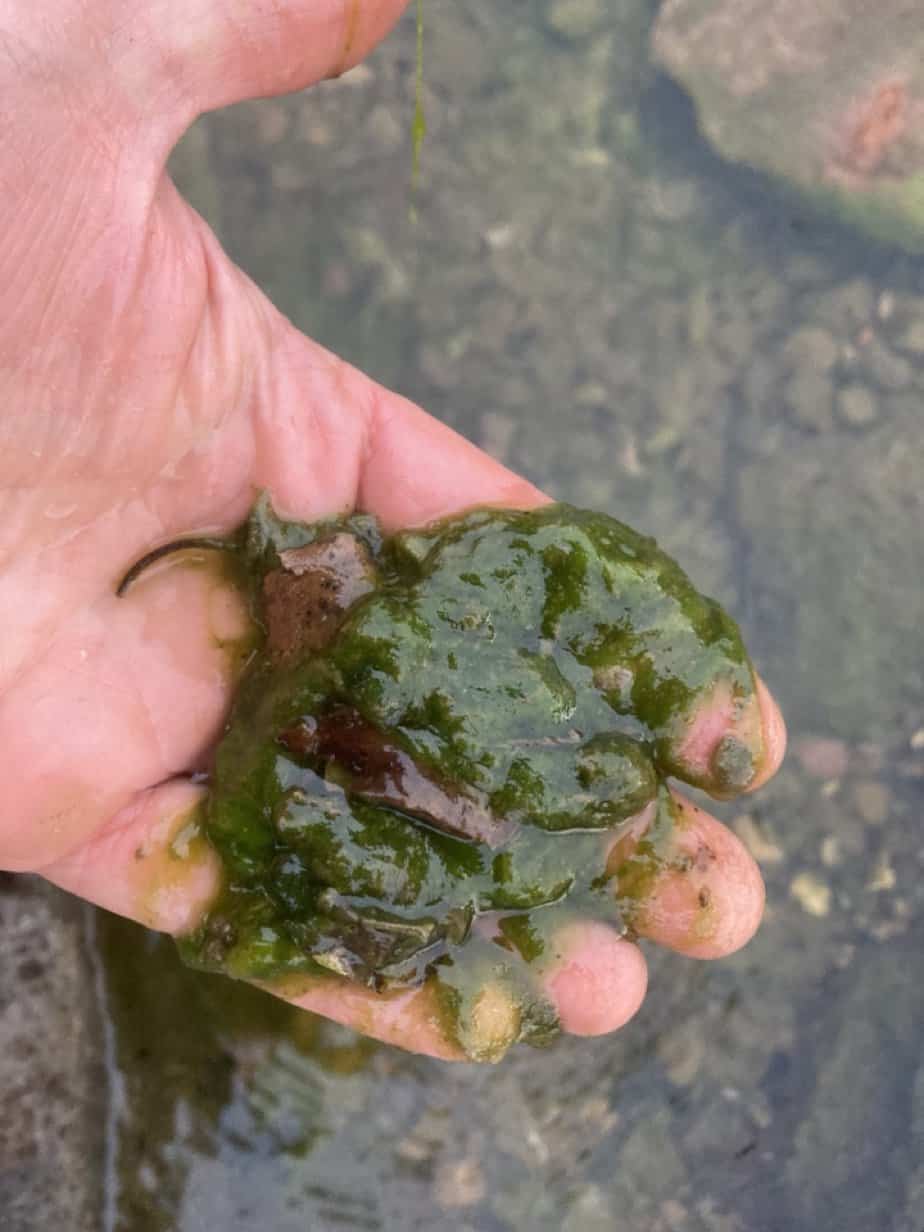Algae: it’s the unsung, and often unwelcome, guest in any pond. While some people might appreciate its presence, for most pond owners, algae can be a bit of a headache. However, understanding its role and managing its growth is crucial for a healthy aquatic ecosystem.
So, how much algae is too much, and what can you do about it? These are just my personal experiences and offer and insight into how I deal with algae in my ponds. You can either watch the video below or read this article.
Why Algae Matters
When it comes to pond maintenance, algae often get a bad rap. Many pond owners view it as a nuisance that turns their clear waters into a green, murky mess. However, algae play a crucial role in the aquatic ecosystem.
Understanding why algae matter can help you appreciate their presence and manage them more effectively. Here’s a deeper look into the importance of algae.
The Ecological Role of Algae
Algae are fundamental to any aquatic ecosystem, including ponds. Here are several reasons why algae are important:
- Primary Producers:
- Photosynthesis: Algae perform photosynthesis, converting sunlight into energy. This process produces oxygen, which is essential for the survival of fish and other aquatic organisms.
- Food Source: Algae are at the base of the food chain. They provide a primary food source for many microorganisms and small aquatic animals, which in turn feed larger creatures.
- Nutrient Cycling:
- Nutrient Uptake: Algae absorb nutrients like nitrogen and phosphorus from the water, which can help prevent the buildup of these substances. In controlled amounts, algae can contribute to nutrient balance in your pond.
- Waste Processing: Algae help in breaking down waste products in the pond. Fish waste and decaying organic matter release nutrients that algae can utilize, thus aiding in the decomposition process.
- Habitat and Shelter:
- Microhabitats: Algae create microhabitats for small aquatic organisms. These microorganisms can help maintain the overall health of your pond by consuming detritus and breaking down organic matter.
- Protection: Algae can provide shelter and protection for small fish and invertebrates. They offer hiding spots that can help these creatures avoid predators.
The Balance of Algae in Ponds
While algae are beneficial, an overabundance can disrupt the balance of your pond ecosystem. Here’s why it’s it’s a good idea to not let algae get out of control:
- Oxygen Levels:
- Oxygen Production and Consumption: Algae produce oxygen during the day through photosynthesis but consume it at night through respiration. An excess of algae can lead to oxygen depletion, especially at night, which can harm fish and other aquatic life.
- Algal Blooms: Large algal blooms can cause oxygen levels to fluctuate dramatically, leading to periods of hypoxia (low oxygen levels) that can be deadly for fish.
- Water Quality:
- Clarity: Excessive algae, particularly single-cell algae, can turn your pond water into a green, soupy mess, affecting water clarity and aesthetic appeal.
- Nutrient Imbalance: Too much algae indicates an imbalance of nutrients, primarily nitrogen and phosphorus. This imbalance can lead to further water quality issues and promote the growth of unwanted plant species.
- Impact on Aquatic Life:
- Habitat Degradation: Overgrown algae can clog filters, pumps, and other pond equipment, making maintenance more challenging and potentially damaging the habitat.
- Competition: Excess algae can outcompete other aquatic plants for nutrients and light, reducing biodiversity and affecting the overall health of your pond ecosystem.
Managing Algae for a Healthy Pond
Maintaining the right balance of algae involves several strategies:
- Proper Filtration:
- Biological Filtration: Ensuring your pond has an adequate biological filtration system helps keep nutrient levels in check. Beneficial bacteria in the filter break down waste products and excess nutrients that algae feed on.
- Mechanical Filtration: Regular cleaning and maintenance of mechanical filters can help remove excess algae and prevent clogging.
- Natural Controls:
- Aquatic Plants: Adding more aquatic plants can compete with algae for nutrients and provide shade, reducing light penetration and limiting algae growth.
- Manual Removal: Regularly removing excess algae by hand or using nets can help keep their growth under control.
- Avoid Overfeeding:
- Fish Feeding: Overfeeding fish contributes to excess nutrients in the water. Feed your fish sparingly to reduce nutrient buildup that can fuel algae growth.
- Patience with New Ponds:
- Establishing Balance: New ponds require time to establish a balanced ecosystem. Be patient and allow beneficial bacteria and microorganisms to proliferate, which will help manage algae naturally over time.
Understanding Algae Types
There are thousands of algae species, but two main types often plague pond owners:
- Single Cell Algae: This type floats in the water, turning your pond into a green, murky soup.
- String Algae: These grow in strands, clinging to rocks, plants, and pond walls.
Both types thrive on light, nitrogen, and phosphorus, which are abundant in most ponds, especially those with poor filtration.
The Role of Filtration
Ponds with inadequate filtration are more prone to algae problems. Good bacteria and microorganisms, crucial for processing nutrients. Having a good biological filter such as a bog filter is a step in the right direction.
Below is a helpful video on the role of biological filtration (bacteria) in a pond. If you would prefer to read an article click here.
Managing Algae in New Ponds
For new ponds (under two years old), patience and proper filtration are your best allies. Avoid quick fixes or chemical treatments that promise instant results.
If the algae is really bad, there are some products I’m happy to use in my ponds and you can find them on the helpful pond products page. Your main focus, should be on establishing a robust biological filtration system.
Here’s a video where I talk about my own issues with new pond algae.
Dealing with Algae in Mature Ponds
For older ponds, excessive algae indicate an imbalance in the ecosystem. Often, the problem lies in the filtration system’s capacity relative to the pond’s biological load. Here’s how you can address it:
- Enhance Filtration: Ensure your filtration system is adequate for the pond’s size and fish population.
- Manual Removal: Regularly remove string algae manually to help the pond regain balance.
- Natural Solutions: Introduce more plants, which compete with algae for nutrients and provide shade, reducing light penetration.
Again one of the reasons why I like a bog filter. I find its easy to size the bog filter for the ponds intended use. A well designed bog is easy to maintain, reducing the need to manually remove algae and debris and it’s a natural method of filtering water.
If you are interested in building a pond with a bog filter, my helpful pdf with formulas I use, could be helpful.
Seasonal Algae Growth
Algae growth varies with seasons. In cooler climates, you might notice more algae in late autumn, winter, and early spring when bacteria and fish are less active.
Conversely, warmer weather can also spur algae growth. In such cases, floating plants or wetlands can help control the problem by absorbing excess nutrients.
I generally find the more stable the weather the more stable the pond. Remember often algae is temporary as the bacteria adapts to a new normal. Again, patience is key!
Preventing Algae Blooms
To prevent algae blooms, especially in warmer months, maintain sensible stocking levels and avoid overfeeding your fish. Algae consume and produce oxygen, so an algae bloom can deplete oxygen levels, especially in warmer water, leading to fish die-offs.
Ensure your pond has adequate oxygenation and filtration to avoid such issues. Below is a video where I talk about the importance of aeration.
Conclusion
Owning a pond can be a rewarding experience if you maintain a balanced ecosystem. By understanding algae’s role and managing its growth through proper filtration, sensible stocking, and natural methods, you can enjoy a clear, healthy pond.
The aim of my Youtube channel and website is to offer DIY methods and practical advice to help you achieve this balance.
I hope you found these tips helpful, thanks for reading and good luck with your pond!

